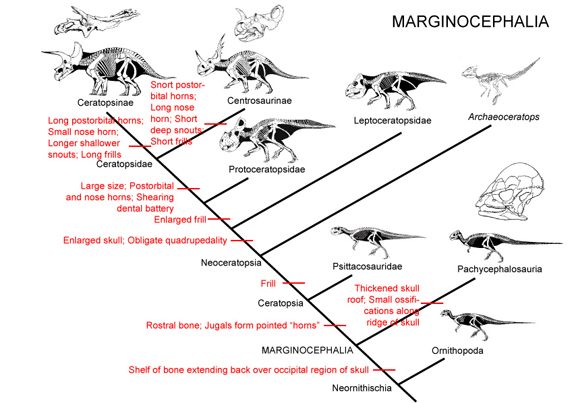Marginocephalian skulls show a lot of suggestions of display and/or combat

Some paleontologists have suggested that the ?Late Triassic through Late Jurassic Heterodontosauridae
were more closely related to marginocephalians than to true ornithopods. If so, these would
be the oldest members of this lineage.
Except for a few fragmentary specimens, all marginocephalians known fall into one or the other
of two clades: the thick-skulled Pachycephalosauria or the deep-beaked (and often frilled
(and sometimes horned)) Ceratopsia.
Pachycephalosaurs:
- Sometimes called boneheads or domeheads or buttheads
- Except for a possible Early Cretaceous form from Europe, are known only from the
Late Cretaceous of Asia and western North America
- Obligate bipeds
- Postcranially resemble heavy hypsilophodonts
- Most obvious derived feature: thickened bone on skull roof
- In primitive forms, the skull is still relatively flat
- In advanced forms, this thickened roof forms a dome
- Suggested behavior uses for these domes:
- Used to butt theropod legs and bellies as defense
- Used like the horns of bighorn sheep in dominance fights for females or territory
- Some indication of sexual dimorphism, with bigger domed males and smaller domed females
- Pachycephalosaurs also have rows of small dermal ossifications around back of skull
- Some indication of strengthened cervical and dorsal vertebrae (for absorbing impacts?)
- Most were smaller than humans; only last and largest (Pachycephalosaurus)
was bigger than a human
- Relatively unsophisticated jaws and teeth
- Relatively rare, seem to have preferred drier environments
The other main branch of the marginocephalians are the ceratopsians:
- Oldest known ceratopsians are from the Late Jurassic of Asia (Yinlong, Chaoyangosaurus)
- Well known (from dozens of skeletons) is the Early Cretaceous Psittacosaurus
- Early marginocephalians were bipeds (possibly facultative bipeds), with bodies like
heavily build hypsilophodonts
- Synapomorphies of Ceratopsia:
- Rostral bone, a bone unique to Ceratopsia
- A single, non-paired bone
- Attached in front of the premaxillae (and so it is a pre-premaxilla!)
- Forms the upper part of the beak, mirror image of the predentary
- Jugals form pointed "cheek bones"
- Ceratopsians have very deep and powerful jaws, with strong shearing bite
Liaoceratops, an Early Cretaceous contemporary of Psittacosaurus, is currently
the oldest known member of the more advanced ceratopsian clade Neoceratopsia:
- Neoceratopsians characterized by a frill
- Frill formed by extensions of the parietal and squamosal
- Served in part as increased surface attachement for jaw muscles
- Very likely was also used as a visual display
- Neoceratopsians also have enlarged heads (that is, their heads are 20% or more the
length of the postcranium)
- Early neoceratopsian, such as late Early Cretaceous Archaeoceratops were
still bipedal
- More advanced neoceratopsians had larger frills and heads, forcing them to become
obligate quadrupeds
- Protoceratopsids of the Late Cretaceous of Mongolia and leptoceratopsids
of the Late Cretaceous of Asia and western North America represent this grade of neoceratopsians.
Some neoceratopsians developed postorbital horns (one over each eye) and nasal
horns. These are the Ceratopsidae. All known ceratopsids are from western
North America; all are from the later part of the Late Cretaceous.
Ceratopsids also have a shearing dental battery of teeth, with a continuous cutting
surface. Coupled with their powerful jaw muscles, they probably had an extremely powerful
shearing bite for dealing with tough plants.
Ceratopsids are larger than most "protoceratopsian"-grade neoceratopsians .
Ceratopsids are divided into two clades:
- Centrosaurinae, with smaller postorbital horns, long nose horns,
short deep snouts in front of the orbit.
- Ceratopsinae (sometimes called Chasmosaurinae), with longer
postorbital horns, smaller nose horns, long shallow snouts, and generally
longer frills
- Triceratops of the latest Cretaceous of western North America is a
ceratopsine
Both ceratopsid clades contained species that lived in herds.
Where known, juvenile centrosaurines of all species resemble each other, and only develop
their autapomorphic features when nearly fully grown. (This may be true for ceratopsines,
but they are not known from many juvenile specimens yet).
Ceratopsine postorbital horns sometimes show wear or breakage halfway down their length, and
there are puncture marks on some frills. Their horns may have been used for within-species
combat for dominance.
To Next Lecture.
To Previous Lecture.
To Syllabus.
Last modified: 14 July 2006


